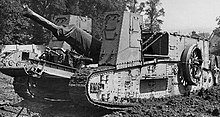Tank artillery
As artillery pieces that part of the artillery designated with the armored vehicles (mostly self-propelled howitzers (PzH) ) is provided.
Protection type
Although the construction of the chassis with caterpillar tracks usually corresponds to that of a battle tank in its original or modified form, the hull and turret differ fundamentally from those of a battle tank because of the different requirements. This type of gun has the advantage, on the one hand, that it allows the firing positions to be changed quickly before the enemy artillery can fire them, and on the other hand, that it offers the crews increased protection through the armor in the event of fire.
history
First forms a mobilized on self-propelled armored artillery subsets already existed during the First World War , such as the British Gun Carrier Mark I . However, these development approaches were not pursued further later.
The first armored artillery pieces were the assault guns in World War II , which were used to support the infantry .
Self-propelled howitzers like the German Hummel design emerged during World War II to give artillery units greater mobility and a certain amount of protection so that tank units could be accompanied and supported directly. The artillery should be able to be used in a mobile manner to combat battle tanks and infantry. The armored artillery as part of the artillery branch did not emerge until after the Second World War , when fully armored self-propelled howitzers were constructed.
In the army of the German Armed Forces , the artillery battalions of the brigades were equipped with self-propelled howitzers in order to be able to follow and support the tank and tank grenadier units directly in combined arms combat. The artillery regiments of the divisions mostly had rifled field howitzers and field cannons on self-propelled guns, as well as rocket artillery on self-propelled guns.
Meaning today
The tasks of the artillery are to fight enemy point or area targets (enemy artillery, facilities and moving targets) in the depth of the space in front of one's own lines. Modern positioning techniques ( artillery reconnaissance radar ) enable rapid counterfire. The consequence is an extensive replacement of drawn artillery pieces by tank artillery. This is because their movable artillery can usually leave the firing position after a fire before the enemy artillery can locate the firing position and fire it. That said, an artillery system is significantly more cost effective than a missile system, which is why artillery is still used in many armies around the world.
Disadvantages of the tank artillery are their high purchase costs and a very high maintenance and fuel requirement on land marches. Relocation in operational transport is only possible overland with heavy-duty transport vehicles (armored transporters) or in air or sea transport with heavy-duty transport machines or ferry and car transport ships. An overland march can lead to considerable damage to the transport infrastructure.
The troop leader has the option of quickly and flexibly forming or relocating the focus on the battlefield . The autonomy of fire control and navigation, as well as mobility and the large number of types of ammunition available are decisive for their operational value.
The American M109 self - propelled howitzer from the 1960s is often used in western armies . The latest Russian model is the 152 mm self-propelled gun 2S35 Koalizija-SW . The Bundeswehr has the self-propelled howitzer 2000 . The maximum shooting range is 30 km with standard ammunition and 56 km with extended range ammunition. The PzH 2000 is regarded worldwide as the benchmark for self-propelled howitzers in operation. However, due to the high production costs in Germany and the small number of items produced, it is considerably more expensive than the South Korean competitor model, the K9 Thunder .
Web links
- Defense Threat Information Group. ( Memento from October 29, 2013 in the Internet Archive ) Overview of tank artillery (German / English)
Individual evidence
- ↑ Nicholas de Larrinaga: Russia's armor revolution. In: janes.com. IHS Jane's 360, May 16, 2015, accessed on May 21, 2015 (English): "According to Georgy Zakamennih, chief director of TsNII Burevestnik, the developer of the 2S35, Coalition-SV has a maximum range of 70 km when firing advanced shells. "



